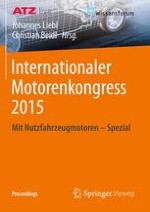2015 | OriginalPaper | Buchkapitel
Neue Technologien für Aufladung – Abgasnachbehandlung – Kraftstoffe
verfasst von : Michael Ward, Fred Huscher, Austin Hoke, Allan Kelly, Brock Fraser, Wolfgang Gstrein, Dr., Daniel Assalve, Dipl.-Ing. (FH), Ralph Wachter, Dipl.-Ing. (FH), Herbert Knorr, Maximilian Weidner, Dipl.-Ing., Bruno Barciela, Dr.-Ing, Benjamin Tilch, Reza Rezaei, Dr., Christoph Bertram, Dr., Peter van Horrick, Jörn Seebode, Dr.
Erschienen in: Internationaler Motorenkongress 2015
Verlag: Springer Fachmedien Wiesbaden
Aktivieren Sie unsere intelligente Suche, um passende Fachinhalte oder Patente zu finden.
Wählen Sie Textabschnitte aus um mit Künstlicher Intelligenz passenden Patente zu finden. powered by
Markieren Sie Textabschnitte, um KI-gestützt weitere passende Inhalte zu finden. powered by
Engine manufacturers have been increasingly pressured by legislation and economics to reduce emissions and deliver improved fuel economy. A common strategy is to downsize and downspeed engines, and then compensate for the affected transient drivability through turbocharging, transmission and axle adjustments. This strategy can be highly effective, but there is a limit to how far it can be exploited before transient boost pressure, and hence transient torque, becomes too detrimental. Turbocharger manufacturers have mitigated this transient lack of exhaust enthalpy using technologies such as VTG (variable turbine geometry) and two-stage charging, especially with EGR-equipped air systems. Parallel to this issue but not separate is the scenario that sometimes the engine has more exhaust enthalpy than what is needed to power the turbocharger compressor. As a function of driver behaviour and the type of vehicle mission, the usage typically oscillates between these two conditions – too much energy or not enough.
These issues have been combated using technologies such as turbocompounding, waste heat recovery bottoming cycles and boost assist devices. Most have the restriction of only being able to deal with one of the two issues, either helping with transient boost or attempting to harvest and convert excess exhaust gas energy. An elegant solution to this problem would be to capitalize on the advances in power electronics and motor materials to electrify the turbocharger that is already packaged within the engine space. This electrified turbocharger would be able to harvest any excess enthalpy not currently needed to drive the compressor and at other times use that same stored energy to overcome transient boost lag.
A key development objective of the electrified turbo (eTurbo™) was to maximize power density. This resulted in a choice to select a permanent magnet electric machine that was placed within the bearing housing of the turbo. This design path was faced with considerable rotordynamic challenges due to placing a third high-mass object on the high speed turbocharger shaft. BorgWarner also chose to develop the eTurbo™ concurrently with the build of a mild-hybrid demonstration vehicle. This approach was taken not only to use the truck as a source of data but more importantly to experience and overcome system integration challenges and to gain integration practice.
The eTurbo™ equipped vehicle is minimally invaded since the turbocharger length grows by only 65mm. The power electronics controller is also quite small and adds just 12kg to vehicle mass. The battery pack is sized in accordance to the type of usage cycle and the final impact is the addition of either a mild hybrid addition to the powertrain or to implement electrified accessories. The end result is being able to use the generated power to offset fuel usage.
On an 11-liter long haul application, simulated fuel economy improvement of using an eTurbo™ on a ESC 13-mode steady-state test predicts maximum improvement of 5.6% and a 3.1% improvement at a key A50 road-cruise condition. Additional simulation of the turbo in a mildly hybridized 7-liter vehicle driving a city cycle showed fuel economy improvements up to 11% due to the combination of low levels of regenerative braking from the mild hybrid system and the power recovered by the eTurbo™.
For engine manufacturers looking to downsize and downspeed or even just improve drivability, the eTurbo™ is an attractive technology that does not require a fully hybridized vehicle or an overly expensive electrical infrastructure. Additionally, the eTurbo™ architecture is minimally invasive in comparison to the complexity of other waste heat recovery and boost-assist technologies.
